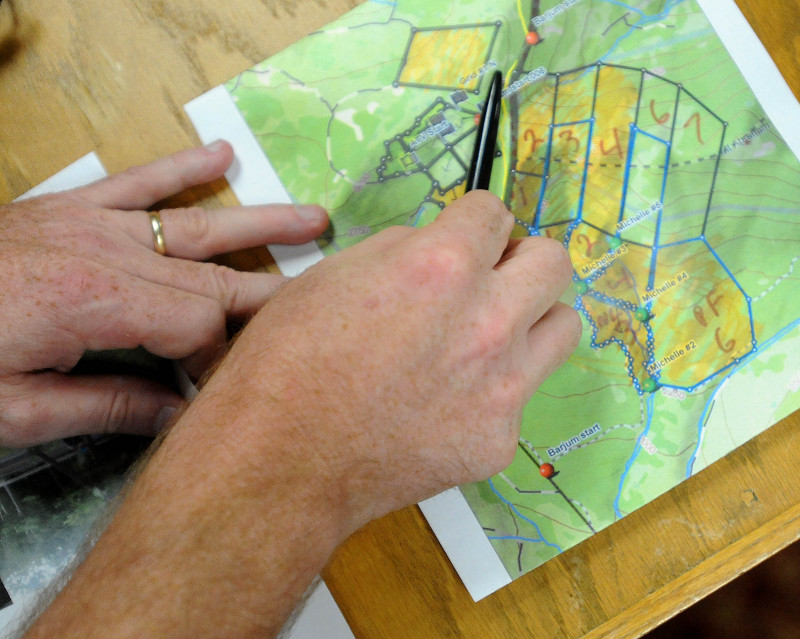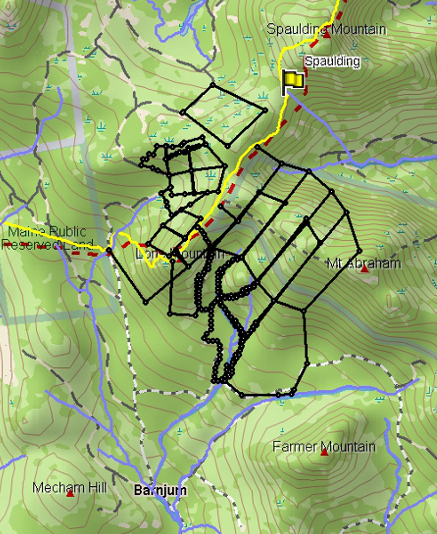CARRABASSETT VALLEY — The search for missing hiker Geraldine Largay will be “extensively scaled back,” the Maine Warden Service announced tonight, after a narrowed search of 4.2-square-miles of rough, mountainous terrain gave no answers about her disappearance.
This morning, the Warden Service said a more in-depth search of the area where they believed Largay might be more effective than the “hasty” searches that had been conducted since she was reported missing July 24.
“At the conclusion of today’s search efforts there was no new attributing evidence or information found as to Geraldine’s location,” said Cpl. John MacDonald in a press release at 8 p.m.
MacDonald said today’s search by 115 volunteers — including wardens, dog teams, trained foot searchers and searchers on horseback — was concentrated in a 4.2 miles square between Lone Mountain and Mount Abraham.
“This search area was established based on several pieces of information gathered from hikers,” he said in the press release.
He said wardens will continue to investigate all leads: “In the event new information becoms available, local wardens and (Maine Association for Search and Rescue) searchers will be used to search those areas.”
At a press conference this morning, Warden Service Lt. Kevin Adam said of the search, “There is no easy way to do this.”
“We have to get people in there and search as best they can,” he said. “I don’t know where some of this is going, but we have a good search plan.”
“It is very frustrating to leave the family in limbo. We don’t ever like to do that. Everybody here feels that, and they’re out there doing the best they can,” said Adam.
The 66-year-old hiker was last seen July 23. Her husband, George Largay, reported that she did not make it to a scheduled supply drop-off along the Appalachian Trail on July 24.
Today’s search was in area called Barnjum. It was the first day that searchers used a grid search, rather than hasty searches.
In a hasty search, searchers quickly move along features such as trails, roads, streams or other natural paths where a lost person would be likely to be found, said Adam. A grid search, which requires more time and resources, involves a nearly shoulder-to-shoulder walk of the area along a grid map laid out by GPS. Everything is thoroughly searched, including bush and brush, he said.
Challenges to the search included rocky terrain and cliff-like dropoffs where Adam said Largay could have fallen, especially in the dark. The Warden Service had put out a call for more experienced searchers — those certified by the Maine Association of Search and Rescue — late last week because of the landscape.
Largay was last seen at the Spaulding Mountain lean-to on July 23. Her husband reported her missing at around 1:15 p.m. the next day.
Adam said that the ground search is just half of the investigation into Largay’s disappearance. Wardens today were still collecting physical and anecdotal evidence that could offer a clue. Adam said they collected plastic bags, shoes and walking poles from the trail to show Largay’s family — but none of them belong to her.
“The investigative side has gotten us everything that we have so far. It’s shortened up the area where she might be, it’s given us sightings and we’re going to continue with that. There are still people we haven’t talked to on the trail,” said Adam.
Adam said that the seven-mile stretch of trail Largay was attempting at the time she disappeared, from Poplar Ridge to Spaulding Mountain, was “well within her range of being able to do.”
He said it is rare for an Appalachian Trail hiker to be lost as long as Largay has been gone, that 98 percent of those missing from the trail are found within 48 hours. Of the remaining two percent, some of those are drowning victims. For Largay to be missing for so long on land is almost unheard of.
Crime reported on the Appalachian Trail in Maine is rare, he said, yet wardens are not ruling out the possibility of foul play.
Largay began her hike of the northern half of the 2,200 trail in April in West Virginia. She’d gone about 950 miles and was about 200 miles from the trail’s northern end, Baxter Peak at the summitt of Mount Katahdin, when she disappeared.
Rachel Ohm — 612-2368
rohm@mainetoday.com
Send questions/comments to the editors.








Success. Please wait for the page to reload. If the page does not reload within 5 seconds, please refresh the page.
Enter your email and password to access comments.
Hi, to comment on stories you must . This profile is in addition to your subscription and website login.
Already have a commenting profile? .
Invalid username/password.
Please check your email to confirm and complete your registration.
Only subscribers are eligible to post comments. Please subscribe or login first for digital access. Here’s why.
Use the form below to reset your password. When you've submitted your account email, we will send an email with a reset code.